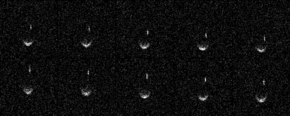 Arecibo Observatory radar images of 2009 FD | |
| Discovery [1] | |
|---|---|
| Discovered by | Spacewatch |
| Discovery site | Kitt Peak National Obs. |
| Discovery date | 24 February 2009 |
| Designations | |
| (410777) 2009 FD | |
| 2009 FD | |
| Orbital characteristics [1] | |
| Epoch 3 July 2013 (JD 2456476.5) | |
| Uncertainty parameter 0 | |
| Observation arc | 6.77 yr (2,471 days) |
| Aphelion | 1.7361 AU |
| Perihelion | 0.5896 AU |
| 1.1629 AU | |
| Eccentricity | 0.4929 |
| 1.25 yr (458 days) | |
| 98.579° | |
| 0° 47m 9.6s / day | |
| Inclination | 3.1366° |
| 9.5523° | |
| 281.24° | |
| Known satellites | 1 [3] |
| Earth MOID | 0.0025 AU (1 LD) |
| Physical characteristics | |
| Mass | 8.3×1010 kg (assumed) [7] |
| 22.1 [1] [4] | |
(410777) 2009 FD is a carbonaceous sub-kilometer asteroid and binary system, [6] [3] classified as near-Earth object and potentially hazardous asteroid of the Apollo group, discovered on 24 February 2009 by astronomers of the Spacewatch program at Kitt Peak National Observatory near Tucson, Arizona, in the United States. [2]
Contents
- Discovery
- Binary
- Future approaches
- Past Earth-impact estimates
- See also
- Notes
- References
- External links
Until 2019, the asteroid's modelled orbit placed it at risk of a possible future collision with Earth in 2185. With a Palermo scale rating of -0.44, it had the fifth highest impact threat [b] of all known asteroids based on its estimated diameter, kinetic yield, impact probability, and time interval. [12] Observations in 2019 extended the observation arc by four years and detected a favourable Yarkovsky effect, which ruled out impact in 2185. [13] Using observations from 16 November 2020, the asteroid was removed from the Sentry risk table on 19 November 2020.




